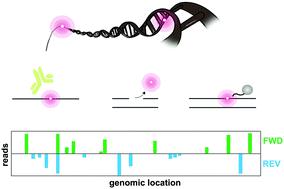当前位置:
X-MOL 学术
›
Chem. Soc. Rev.
›
论文详情
Our official English website, www.x-mol.net, welcomes your feedback! (Note: you will need to create a separate account there.)
Next-generation DNA damage sequencing.
Chemical Society Reviews ( IF 46.2 ) Pub Date : 2020-09-24 , DOI: 10.1039/d0cs00647e Cécile Mingard 1 , Junzhou Wu , Maureen McKeague , Shana J Sturla
Chemical Society Reviews ( IF 46.2 ) Pub Date : 2020-09-24 , DOI: 10.1039/d0cs00647e Cécile Mingard 1 , Junzhou Wu , Maureen McKeague , Shana J Sturla
Affiliation

|
Cellular DNA is constantly chemically altered by exogenous and endogenous agents. As all processes of life depend on the transmission of the genetic information, multiple biological processes exist to ensure genome integrity. Chemically damaged DNA has been linked to cancer and aging, therefore it is of great interest to map DNA damage formation and repair to elucidate the distribution of damage on a genome-wide scale. While the low abundance and inability to enzymatically amplify DNA damage are obstacles to genome-wide sequencing, new developments in the last few years have enabled high-resolution mapping of damaged bases. Recently, a number of DNA damage sequencing library construction strategies coupled to new data analysis pipelines allowed the mapping of specific DNA damage formation and repair at high and single nucleotide resolution. Strikingly, these advancements revealed that the distribution of DNA damage is heavily influenced by chromatin states and the binding of transcription factors. In the last seven years, these novel approaches have revealed new genomic maps of DNA damage distribution in a variety of organisms as generated by diverse chemical and physical DNA insults; oxidative stress, chemotherapeutic drugs, environmental pollutants, and sun exposure. Preferred sequences for damage formation and repair have been elucidated, thus making it possible to identify persistent weak spots in the genome as locations predicted to be vulnerable for mutation. As such, sequencing DNA damage will have an immense impact on our ability to elucidate mechanisms of disease initiation, and to evaluate and predict the efficacy of chemotherapeutic drugs.
中文翻译:

下一代DNA损伤测序。
细胞DNA经常被外源性和内源性化学改变。由于生命的所有过程都取决于遗传信息的传递,因此存在多种生物学过程来确保基因组的完整性。化学损伤的DNA与癌症和衰老有关,因此,绘制DNA损伤的形成和修复图以阐明损伤在全基因组范围内的分布非常重要。低丰度和无法酶促扩增DNA损伤是全基因组测序的障碍,而最近几年的新进展使得能够对受损碱基进行高分辨率定位。最近,许多DNA损伤测序文库的构建策略与新的数据分析管道相结合,允许以高和单核苷酸分辨率绘制特定DNA损伤的形成和修复图。令人惊讶的是,这些进展表明,DNA损伤的分布在很大程度上受染色质状态和转录因子结合的影响。在过去的七年中,这些新颖的方法揭示了各种化学和物理DNA损伤产生的各种生物中DNA损伤分布的新基因组图。氧化应激,化学治疗药物,环境污染物和阳光暴晒。已经阐明了用于损伤形成和修复的优选序列,从而使得有可能将基因组中的持久性弱点鉴定为预计易受突变影响的位置。因此,对DNA损伤进行测序将对我们阐明疾病引发机制以及评估和预测化疗药物功效的能力产生巨大影响。这些进展表明,DNA损伤的分布在很大程度上受染色质状态和转录因子结合的影响。在过去的七年中,这些新颖的方法揭示了各种化学和物理DNA损伤产生的各种生物中DNA损伤分布的新基因组图。氧化应激,化学治疗药物,环境污染物和阳光暴晒。已经阐明了用于损伤形成和修复的优选序列,从而使得有可能将基因组中的持久性弱点鉴定为预计易受突变影响的位置。因此,对DNA损伤进行测序将对我们阐明疾病引发机制以及评估和预测化疗药物功效的能力产生巨大影响。这些进展表明,DNA损伤的分布在很大程度上受染色质状态和转录因子结合的影响。在过去的七年中,这些新颖的方法揭示了各种化学和物理DNA损伤产生的各种生物中DNA损伤分布的新基因组图。氧化应激,化学治疗药物,环境污染物和阳光暴晒。已经阐明了用于损伤形成和修复的优选序列,从而使得有可能将基因组中的持久性弱点鉴定为预计易受突变影响的位置。因此,对DNA损伤进行测序将对我们阐明疾病引发机制以及评估和预测化疗药物功效的能力产生巨大影响。
更新日期:2020-10-19
中文翻译:

下一代DNA损伤测序。
细胞DNA经常被外源性和内源性化学改变。由于生命的所有过程都取决于遗传信息的传递,因此存在多种生物学过程来确保基因组的完整性。化学损伤的DNA与癌症和衰老有关,因此,绘制DNA损伤的形成和修复图以阐明损伤在全基因组范围内的分布非常重要。低丰度和无法酶促扩增DNA损伤是全基因组测序的障碍,而最近几年的新进展使得能够对受损碱基进行高分辨率定位。最近,许多DNA损伤测序文库的构建策略与新的数据分析管道相结合,允许以高和单核苷酸分辨率绘制特定DNA损伤的形成和修复图。令人惊讶的是,这些进展表明,DNA损伤的分布在很大程度上受染色质状态和转录因子结合的影响。在过去的七年中,这些新颖的方法揭示了各种化学和物理DNA损伤产生的各种生物中DNA损伤分布的新基因组图。氧化应激,化学治疗药物,环境污染物和阳光暴晒。已经阐明了用于损伤形成和修复的优选序列,从而使得有可能将基因组中的持久性弱点鉴定为预计易受突变影响的位置。因此,对DNA损伤进行测序将对我们阐明疾病引发机制以及评估和预测化疗药物功效的能力产生巨大影响。这些进展表明,DNA损伤的分布在很大程度上受染色质状态和转录因子结合的影响。在过去的七年中,这些新颖的方法揭示了各种化学和物理DNA损伤产生的各种生物中DNA损伤分布的新基因组图。氧化应激,化学治疗药物,环境污染物和阳光暴晒。已经阐明了用于损伤形成和修复的优选序列,从而使得有可能将基因组中的持久性弱点鉴定为预计易受突变影响的位置。因此,对DNA损伤进行测序将对我们阐明疾病引发机制以及评估和预测化疗药物功效的能力产生巨大影响。这些进展表明,DNA损伤的分布在很大程度上受染色质状态和转录因子结合的影响。在过去的七年中,这些新颖的方法揭示了各种化学和物理DNA损伤产生的各种生物中DNA损伤分布的新基因组图。氧化应激,化学治疗药物,环境污染物和阳光暴晒。已经阐明了用于损伤形成和修复的优选序列,从而使得有可能将基因组中的持久性弱点鉴定为预计易受突变影响的位置。因此,对DNA损伤进行测序将对我们阐明疾病引发机制以及评估和预测化疗药物功效的能力产生巨大影响。



























 京公网安备 11010802027423号
京公网安备 11010802027423号